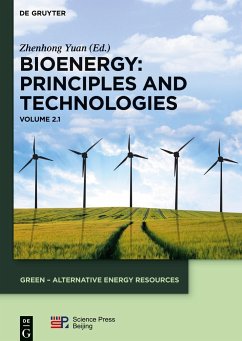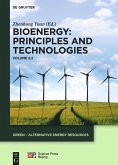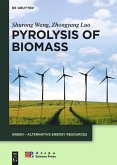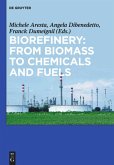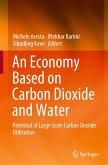Bioenergy: Principles and Technologies
Volume 2.1
Herausgegeben:Yuan, Zhenhong;Mitarbeit:China Science Publishing & Media Ltd.
Bioenergy: Principles and Technologies
Volume 2.1
Herausgegeben:Yuan, Zhenhong;Mitarbeit:China Science Publishing & Media Ltd.
- Gebundenes Buch
- Merkliste
- Auf die Merkliste
- Bewerten Bewerten
- Teilen
- Produkt teilen
- Produkterinnerung
- Produkterinnerung
Bioenergy: Principles and Technologies introduces biomass energy resources and then elaborates on bioenergy technologies including biomass combustion, biogas production, biomass briquettes and biomass gasification. With a combination of theories, experiments and case studies, the book is an essential reference for bioenergy researchers, industrial chemists and chemical engineers.
Andere Kunden interessierten sich auch für
![Bioenergy: Principles and Technologies Bioenergy: Principles and Technologies]() Bioenergy: Principles and Technologies129,95 €
Bioenergy: Principles and Technologies129,95 €![Pyrolysis of Biomass Pyrolysis of Biomass]() Shurong WangPyrolysis of Biomass96,99 €
Shurong WangPyrolysis of Biomass96,99 €![Biorefinery: From Biomass to Chemicals and Fuels Biorefinery: From Biomass to Chemicals and Fuels]() Biorefinery: From Biomass to Chemicals and Fuels96,99 €
Biorefinery: From Biomass to Chemicals and Fuels96,99 €![Biorefinery: From Biomass to Chemicals and Fuels Biorefinery: From Biomass to Chemicals and Fuels]() Biorefinery: From Biomass to Chemicals and Fuels159,95 €
Biorefinery: From Biomass to Chemicals and Fuels159,95 €![Einführung in die Chemie nachwachsender Rohstoffe Einführung in die Chemie nachwachsender Rohstoffe]() Arno BehrEinführung in die Chemie nachwachsender Rohstoffe44,99 €
Arno BehrEinführung in die Chemie nachwachsender Rohstoffe44,99 €![An Economy Based on Carbon Dioxide and Water An Economy Based on Carbon Dioxide and Water]() An Economy Based on Carbon Dioxide and Water123,99 €
An Economy Based on Carbon Dioxide and Water123,99 €![Membrane Technologies Membrane Technologies]() Membrane Technologies164,95 €
Membrane Technologies164,95 €-
-
-
Bioenergy: Principles and Technologies introduces biomass energy resources and then elaborates on bioenergy technologies including biomass combustion, biogas production, biomass briquettes and biomass gasification. With a combination of theories, experiments and case studies, the book is an essential reference for bioenergy researchers, industrial chemists and chemical engineers.
Produktdetails
- Produktdetails
- GREEN - Alternative Energy Resources 2, 1
- Verlag: De Gruyter
- Seitenzahl: 358
- Erscheinungstermin: 18. Dezember 2017
- Englisch
- Abmessung: 246mm x 175mm x 25mm
- Gewicht: 732g
- ISBN-13: 9783110344196
- ISBN-10: 311034419X
- Artikelnr.: 44096088
- Herstellerkennzeichnung Die Herstellerinformationen sind derzeit nicht verfügbar.
- GREEN - Alternative Energy Resources 2, 1
- Verlag: De Gruyter
- Seitenzahl: 358
- Erscheinungstermin: 18. Dezember 2017
- Englisch
- Abmessung: 246mm x 175mm x 25mm
- Gewicht: 732g
- ISBN-13: 9783110344196
- ISBN-10: 311034419X
- Artikelnr.: 44096088
- Herstellerkennzeichnung Die Herstellerinformationen sind derzeit nicht verfügbar.
Zhenhong Yuan, Guangzhou Institute of Energy Conversion, Chinese Academy of Sciences, Guangzhou, China
Chapter 1 Introduction
1.1 Biomass energy resources
1.2 Biomass energy utilization technologies
1.3 Biomass energy in the world
1.4 Biomass energy in China
1.5 The strategic role of Biomass energy in China's sustainable development
1.6 The future trends, challenges and choices
Chapter 2 Biomass Energy Resources and Energy Crops
2.1Material basis of biomass energy
2.1.1 Photosynthesis
2.1.2 Biomass feedstock
2.1.3 Characteristics of biomass resources
2.1.4 Chemical composition of biomass
2.1.5 Calorific value of the biomass fuel
2.2 Existing biomass resources in China
2.2.1 Crop straw
2.2.2 Livestock and poultry manure
2.2.3 Forestry residues
2.2.4 Starch resources
2.2.5 Sugar resources
2.2.6 Waste edible oils and fats
2.2.7 Urban living garbage
2.2.8 Industrial organic wastewater
2.3 Energy Crops
2.3.1 Concept of energy crops
2.3.2 Energy crop quality improvement technology
2.3.3 Agricultural crops
2.3.4 Woody oil forest
2.3.5 Woody energy forest
2.3.6 Herbs perennial crops
2.4 Energy Microalgae
2.4.1 Strains of oleaginous microalgae
2.4.2 Isolation and selection of microalgae
2.4.3 Culture of microalgae
2.4.4 Harvesting and oil extraction
2.4.5 Comprehensive utilization of microalgae
2.5 Promising biomass in China
Chapter 3 Technologies of Biomass Combustion
3.1The basic principle of biomass combustion
3.1.1 Biomass combustion process
3.1.1.1 Characteristics of biomass fuel
3.1.1.2 Typical stages of biomass combustion
3.1.1.3 Pyrolysis of biomass fuel
3.1.1.4 Combustion characteristics of biomass charcoal
3.1.2 Issues for biomass combustion
3.1.2.1 Moisture in biomass
3.1.2.2 Burning of volatile
3.1.2.3 Ash relative problems
3.1.2.4 Design of biomass combustion
3.1.3 Pollutants from biomass combustion
3.1.3.1 Dust emission
3.1.3.2 Gaseous pollutants
3.1.3.3 PM from biomass combustion
3.1.3.4 Heavy metal pollution
3.2 House-hold Stove
3.2.1 Energy-saving Stove
3.2.2 Cooking Stove
3.2.3 Cooking and Heating Stove
3.2.4 Warming Stove
3.3 Industrial Technology and Application of Biomass Combustion
3.3.1 Biomass Combustion Technology
3.3.2 Biomass Furnace for Hot Gas
3.3.3 Industrial Boiler for Heat Supply
3.3.4 Utility Boiler
3.3.5 Co-combustion Boiler
Chapter 4 Anaerobic Digestion Process and Biogas Production Technologies
4.1 Basic definitions and theory
4.1.1 Basic concept
4.1.2 Anaerobic digestion theory
4.1.3 Microbiology of biogas production
4.1.4 Microbial regulatory process
4.2 Anaerobic digestion technology and equipment
4.2.1 Pretreatment technology and equipment
4.2.2 Anaerobic digestion technology and equipment
4.2.3 Biogas utilization technology and equipment
4.2.4 Residues utilization technology and equipment
4.3 Application and mode
4.3.1 Mode of hosehold biogas plant
4.3.2 Heat and electric power cogenerate project
4.3.3 Biomethane for vehicle project
4.3.4 Natural gas network or centralized gas supply project
Chapter 5 Technologies of Biomass Briquettes
5.1 Concepts and principles of biomass briquettes
5.1.1 Concept of biomass briquettes
5.1.2 Development history of biomass briquettes
5.1.3 Structure and properties of biomass briquettes
5.1.4 Principles of biomass compression molding
5.2 Technology and equipment of biomass briquetting
5.2.1 Technology and equipment of pre-treatment on biomass briquetting
5.2.2 Technology and equipment of biomass pellet fuel
5.2.3 Technology and equipment of biomass block fuel
5.2.4 Technology and equipment of biomass rod fuel
5.2.5 Industrial production system of biomass briquettes
5.3 Application technology and equipment of biomass briquette
5.3.1Technology and equipment of biomass briquettes combustion
5.3.2 Technology and equipment of biomass briquettes gasification
5.3.3 Technology and equipment of biomass briquettes for household
5.3.4Technology and equipment for carbon-based slow-release fertilizer
5.4Application examples of biomass briquettes
5.4.1 Application examples of large-scale production of biomass briquettes
5.4.2Application examples of biomass briquettes burning and heating
5.4.3 Application examples of biomass briquettes gasification and gas supply
5.5 Technology and industry development trends of biomass briquettes
5.5.1Technology development trends
5.5.1 Industry development trends
Chapter 6 Technologies of Biomass Gasification
6.1 Fundamentals of biomass gasification
6.1.1 Principle of biomass gasification
6.1.2 Fundamental thermochemical reactions in biomass gasification
6.2 Biomass gasifier
6.2.1 Type of biomass gasifiers
6.2.2 Characteristics and application of fixed bed gasifier
6.2.3 Characteristics and application of fluidized bed gasifier
6.2.4 Performances of gasifier and indicators
6.3 Cleaning of biomass gasifier product gas
6.3.1 Composition and properties of biomass gasifier product gas
6.3.2 Removal of ash and moisture
6.3.3 Production and influence of biomass gasification tar
6.3.4 Removal of tar from gasification gas
6.4 Application of biomass gasification technology
6.4.1 Biomass gasification for centralized gas supply
6.4.2 Biomass gasification for power generation
6.4.3 Biomass gasification for thermal drying
6.4.4 Biomass gasification gas used as boiler fuel
6.4.5 Household biomass gasification equipment
6.4.6 Biomass gasification for district heating
6.4.7 Biomass gasification for ammonia synthesis.
1.1 Biomass energy resources
1.2 Biomass energy utilization technologies
1.3 Biomass energy in the world
1.4 Biomass energy in China
1.5 The strategic role of Biomass energy in China's sustainable development
1.6 The future trends, challenges and choices
Chapter 2 Biomass Energy Resources and Energy Crops
2.1Material basis of biomass energy
2.1.1 Photosynthesis
2.1.2 Biomass feedstock
2.1.3 Characteristics of biomass resources
2.1.4 Chemical composition of biomass
2.1.5 Calorific value of the biomass fuel
2.2 Existing biomass resources in China
2.2.1 Crop straw
2.2.2 Livestock and poultry manure
2.2.3 Forestry residues
2.2.4 Starch resources
2.2.5 Sugar resources
2.2.6 Waste edible oils and fats
2.2.7 Urban living garbage
2.2.8 Industrial organic wastewater
2.3 Energy Crops
2.3.1 Concept of energy crops
2.3.2 Energy crop quality improvement technology
2.3.3 Agricultural crops
2.3.4 Woody oil forest
2.3.5 Woody energy forest
2.3.6 Herbs perennial crops
2.4 Energy Microalgae
2.4.1 Strains of oleaginous microalgae
2.4.2 Isolation and selection of microalgae
2.4.3 Culture of microalgae
2.4.4 Harvesting and oil extraction
2.4.5 Comprehensive utilization of microalgae
2.5 Promising biomass in China
Chapter 3 Technologies of Biomass Combustion
3.1The basic principle of biomass combustion
3.1.1 Biomass combustion process
3.1.1.1 Characteristics of biomass fuel
3.1.1.2 Typical stages of biomass combustion
3.1.1.3 Pyrolysis of biomass fuel
3.1.1.4 Combustion characteristics of biomass charcoal
3.1.2 Issues for biomass combustion
3.1.2.1 Moisture in biomass
3.1.2.2 Burning of volatile
3.1.2.3 Ash relative problems
3.1.2.4 Design of biomass combustion
3.1.3 Pollutants from biomass combustion
3.1.3.1 Dust emission
3.1.3.2 Gaseous pollutants
3.1.3.3 PM from biomass combustion
3.1.3.4 Heavy metal pollution
3.2 House-hold Stove
3.2.1 Energy-saving Stove
3.2.2 Cooking Stove
3.2.3 Cooking and Heating Stove
3.2.4 Warming Stove
3.3 Industrial Technology and Application of Biomass Combustion
3.3.1 Biomass Combustion Technology
3.3.2 Biomass Furnace for Hot Gas
3.3.3 Industrial Boiler for Heat Supply
3.3.4 Utility Boiler
3.3.5 Co-combustion Boiler
Chapter 4 Anaerobic Digestion Process and Biogas Production Technologies
4.1 Basic definitions and theory
4.1.1 Basic concept
4.1.2 Anaerobic digestion theory
4.1.3 Microbiology of biogas production
4.1.4 Microbial regulatory process
4.2 Anaerobic digestion technology and equipment
4.2.1 Pretreatment technology and equipment
4.2.2 Anaerobic digestion technology and equipment
4.2.3 Biogas utilization technology and equipment
4.2.4 Residues utilization technology and equipment
4.3 Application and mode
4.3.1 Mode of hosehold biogas plant
4.3.2 Heat and electric power cogenerate project
4.3.3 Biomethane for vehicle project
4.3.4 Natural gas network or centralized gas supply project
Chapter 5 Technologies of Biomass Briquettes
5.1 Concepts and principles of biomass briquettes
5.1.1 Concept of biomass briquettes
5.1.2 Development history of biomass briquettes
5.1.3 Structure and properties of biomass briquettes
5.1.4 Principles of biomass compression molding
5.2 Technology and equipment of biomass briquetting
5.2.1 Technology and equipment of pre-treatment on biomass briquetting
5.2.2 Technology and equipment of biomass pellet fuel
5.2.3 Technology and equipment of biomass block fuel
5.2.4 Technology and equipment of biomass rod fuel
5.2.5 Industrial production system of biomass briquettes
5.3 Application technology and equipment of biomass briquette
5.3.1Technology and equipment of biomass briquettes combustion
5.3.2 Technology and equipment of biomass briquettes gasification
5.3.3 Technology and equipment of biomass briquettes for household
5.3.4Technology and equipment for carbon-based slow-release fertilizer
5.4Application examples of biomass briquettes
5.4.1 Application examples of large-scale production of biomass briquettes
5.4.2Application examples of biomass briquettes burning and heating
5.4.3 Application examples of biomass briquettes gasification and gas supply
5.5 Technology and industry development trends of biomass briquettes
5.5.1Technology development trends
5.5.1 Industry development trends
Chapter 6 Technologies of Biomass Gasification
6.1 Fundamentals of biomass gasification
6.1.1 Principle of biomass gasification
6.1.2 Fundamental thermochemical reactions in biomass gasification
6.2 Biomass gasifier
6.2.1 Type of biomass gasifiers
6.2.2 Characteristics and application of fixed bed gasifier
6.2.3 Characteristics and application of fluidized bed gasifier
6.2.4 Performances of gasifier and indicators
6.3 Cleaning of biomass gasifier product gas
6.3.1 Composition and properties of biomass gasifier product gas
6.3.2 Removal of ash and moisture
6.3.3 Production and influence of biomass gasification tar
6.3.4 Removal of tar from gasification gas
6.4 Application of biomass gasification technology
6.4.1 Biomass gasification for centralized gas supply
6.4.2 Biomass gasification for power generation
6.4.3 Biomass gasification for thermal drying
6.4.4 Biomass gasification gas used as boiler fuel
6.4.5 Household biomass gasification equipment
6.4.6 Biomass gasification for district heating
6.4.7 Biomass gasification for ammonia synthesis.
Chapter 1 Introduction
1.1 Biomass energy resources
1.2 Biomass energy utilization technologies
1.3 Biomass energy in the world
1.4 Biomass energy in China
1.5 The strategic role of Biomass energy in China's sustainable development
1.6 The future trends, challenges and choices
Chapter 2 Biomass Energy Resources and Energy Crops
2.1Material basis of biomass energy
2.1.1 Photosynthesis
2.1.2 Biomass feedstock
2.1.3 Characteristics of biomass resources
2.1.4 Chemical composition of biomass
2.1.5 Calorific value of the biomass fuel
2.2 Existing biomass resources in China
2.2.1 Crop straw
2.2.2 Livestock and poultry manure
2.2.3 Forestry residues
2.2.4 Starch resources
2.2.5 Sugar resources
2.2.6 Waste edible oils and fats
2.2.7 Urban living garbage
2.2.8 Industrial organic wastewater
2.3 Energy Crops
2.3.1 Concept of energy crops
2.3.2 Energy crop quality improvement technology
2.3.3 Agricultural crops
2.3.4 Woody oil forest
2.3.5 Woody energy forest
2.3.6 Herbs perennial crops
2.4 Energy Microalgae
2.4.1 Strains of oleaginous microalgae
2.4.2 Isolation and selection of microalgae
2.4.3 Culture of microalgae
2.4.4 Harvesting and oil extraction
2.4.5 Comprehensive utilization of microalgae
2.5 Promising biomass in China
Chapter 3 Technologies of Biomass Combustion
3.1The basic principle of biomass combustion
3.1.1 Biomass combustion process
3.1.1.1 Characteristics of biomass fuel
3.1.1.2 Typical stages of biomass combustion
3.1.1.3 Pyrolysis of biomass fuel
3.1.1.4 Combustion characteristics of biomass charcoal
3.1.2 Issues for biomass combustion
3.1.2.1 Moisture in biomass
3.1.2.2 Burning of volatile
3.1.2.3 Ash relative problems
3.1.2.4 Design of biomass combustion
3.1.3 Pollutants from biomass combustion
3.1.3.1 Dust emission
3.1.3.2 Gaseous pollutants
3.1.3.3 PM from biomass combustion
3.1.3.4 Heavy metal pollution
3.2 House-hold Stove
3.2.1 Energy-saving Stove
3.2.2 Cooking Stove
3.2.3 Cooking and Heating Stove
3.2.4 Warming Stove
3.3 Industrial Technology and Application of Biomass Combustion
3.3.1 Biomass Combustion Technology
3.3.2 Biomass Furnace for Hot Gas
3.3.3 Industrial Boiler for Heat Supply
3.3.4 Utility Boiler
3.3.5 Co-combustion Boiler
Chapter 4 Anaerobic Digestion Process and Biogas Production Technologies
4.1 Basic definitions and theory
4.1.1 Basic concept
4.1.2 Anaerobic digestion theory
4.1.3 Microbiology of biogas production
4.1.4 Microbial regulatory process
4.2 Anaerobic digestion technology and equipment
4.2.1 Pretreatment technology and equipment
4.2.2 Anaerobic digestion technology and equipment
4.2.3 Biogas utilization technology and equipment
4.2.4 Residues utilization technology and equipment
4.3 Application and mode
4.3.1 Mode of hosehold biogas plant
4.3.2 Heat and electric power cogenerate project
4.3.3 Biomethane for vehicle project
4.3.4 Natural gas network or centralized gas supply project
Chapter 5 Technologies of Biomass Briquettes
5.1 Concepts and principles of biomass briquettes
5.1.1 Concept of biomass briquettes
5.1.2 Development history of biomass briquettes
5.1.3 Structure and properties of biomass briquettes
5.1.4 Principles of biomass compression molding
5.2 Technology and equipment of biomass briquetting
5.2.1 Technology and equipment of pre-treatment on biomass briquetting
5.2.2 Technology and equipment of biomass pellet fuel
5.2.3 Technology and equipment of biomass block fuel
5.2.4 Technology and equipment of biomass rod fuel
5.2.5 Industrial production system of biomass briquettes
5.3 Application technology and equipment of biomass briquette
5.3.1Technology and equipment of biomass briquettes combustion
5.3.2 Technology and equipment of biomass briquettes gasification
5.3.3 Technology and equipment of biomass briquettes for household
5.3.4Technology and equipment for carbon-based slow-release fertilizer
5.4Application examples of biomass briquettes
5.4.1 Application examples of large-scale production of biomass briquettes
5.4.2Application examples of biomass briquettes burning and heating
5.4.3 Application examples of biomass briquettes gasification and gas supply
5.5 Technology and industry development trends of biomass briquettes
5.5.1Technology development trends
5.5.1 Industry development trends
Chapter 6 Technologies of Biomass Gasification
6.1 Fundamentals of biomass gasification
6.1.1 Principle of biomass gasification
6.1.2 Fundamental thermochemical reactions in biomass gasification
6.2 Biomass gasifier
6.2.1 Type of biomass gasifiers
6.2.2 Characteristics and application of fixed bed gasifier
6.2.3 Characteristics and application of fluidized bed gasifier
6.2.4 Performances of gasifier and indicators
6.3 Cleaning of biomass gasifier product gas
6.3.1 Composition and properties of biomass gasifier product gas
6.3.2 Removal of ash and moisture
6.3.3 Production and influence of biomass gasification tar
6.3.4 Removal of tar from gasification gas
6.4 Application of biomass gasification technology
6.4.1 Biomass gasification for centralized gas supply
6.4.2 Biomass gasification for power generation
6.4.3 Biomass gasification for thermal drying
6.4.4 Biomass gasification gas used as boiler fuel
6.4.5 Household biomass gasification equipment
6.4.6 Biomass gasification for district heating
6.4.7 Biomass gasification for ammonia synthesis.
1.1 Biomass energy resources
1.2 Biomass energy utilization technologies
1.3 Biomass energy in the world
1.4 Biomass energy in China
1.5 The strategic role of Biomass energy in China's sustainable development
1.6 The future trends, challenges and choices
Chapter 2 Biomass Energy Resources and Energy Crops
2.1Material basis of biomass energy
2.1.1 Photosynthesis
2.1.2 Biomass feedstock
2.1.3 Characteristics of biomass resources
2.1.4 Chemical composition of biomass
2.1.5 Calorific value of the biomass fuel
2.2 Existing biomass resources in China
2.2.1 Crop straw
2.2.2 Livestock and poultry manure
2.2.3 Forestry residues
2.2.4 Starch resources
2.2.5 Sugar resources
2.2.6 Waste edible oils and fats
2.2.7 Urban living garbage
2.2.8 Industrial organic wastewater
2.3 Energy Crops
2.3.1 Concept of energy crops
2.3.2 Energy crop quality improvement technology
2.3.3 Agricultural crops
2.3.4 Woody oil forest
2.3.5 Woody energy forest
2.3.6 Herbs perennial crops
2.4 Energy Microalgae
2.4.1 Strains of oleaginous microalgae
2.4.2 Isolation and selection of microalgae
2.4.3 Culture of microalgae
2.4.4 Harvesting and oil extraction
2.4.5 Comprehensive utilization of microalgae
2.5 Promising biomass in China
Chapter 3 Technologies of Biomass Combustion
3.1The basic principle of biomass combustion
3.1.1 Biomass combustion process
3.1.1.1 Characteristics of biomass fuel
3.1.1.2 Typical stages of biomass combustion
3.1.1.3 Pyrolysis of biomass fuel
3.1.1.4 Combustion characteristics of biomass charcoal
3.1.2 Issues for biomass combustion
3.1.2.1 Moisture in biomass
3.1.2.2 Burning of volatile
3.1.2.3 Ash relative problems
3.1.2.4 Design of biomass combustion
3.1.3 Pollutants from biomass combustion
3.1.3.1 Dust emission
3.1.3.2 Gaseous pollutants
3.1.3.3 PM from biomass combustion
3.1.3.4 Heavy metal pollution
3.2 House-hold Stove
3.2.1 Energy-saving Stove
3.2.2 Cooking Stove
3.2.3 Cooking and Heating Stove
3.2.4 Warming Stove
3.3 Industrial Technology and Application of Biomass Combustion
3.3.1 Biomass Combustion Technology
3.3.2 Biomass Furnace for Hot Gas
3.3.3 Industrial Boiler for Heat Supply
3.3.4 Utility Boiler
3.3.5 Co-combustion Boiler
Chapter 4 Anaerobic Digestion Process and Biogas Production Technologies
4.1 Basic definitions and theory
4.1.1 Basic concept
4.1.2 Anaerobic digestion theory
4.1.3 Microbiology of biogas production
4.1.4 Microbial regulatory process
4.2 Anaerobic digestion technology and equipment
4.2.1 Pretreatment technology and equipment
4.2.2 Anaerobic digestion technology and equipment
4.2.3 Biogas utilization technology and equipment
4.2.4 Residues utilization technology and equipment
4.3 Application and mode
4.3.1 Mode of hosehold biogas plant
4.3.2 Heat and electric power cogenerate project
4.3.3 Biomethane for vehicle project
4.3.4 Natural gas network or centralized gas supply project
Chapter 5 Technologies of Biomass Briquettes
5.1 Concepts and principles of biomass briquettes
5.1.1 Concept of biomass briquettes
5.1.2 Development history of biomass briquettes
5.1.3 Structure and properties of biomass briquettes
5.1.4 Principles of biomass compression molding
5.2 Technology and equipment of biomass briquetting
5.2.1 Technology and equipment of pre-treatment on biomass briquetting
5.2.2 Technology and equipment of biomass pellet fuel
5.2.3 Technology and equipment of biomass block fuel
5.2.4 Technology and equipment of biomass rod fuel
5.2.5 Industrial production system of biomass briquettes
5.3 Application technology and equipment of biomass briquette
5.3.1Technology and equipment of biomass briquettes combustion
5.3.2 Technology and equipment of biomass briquettes gasification
5.3.3 Technology and equipment of biomass briquettes for household
5.3.4Technology and equipment for carbon-based slow-release fertilizer
5.4Application examples of biomass briquettes
5.4.1 Application examples of large-scale production of biomass briquettes
5.4.2Application examples of biomass briquettes burning and heating
5.4.3 Application examples of biomass briquettes gasification and gas supply
5.5 Technology and industry development trends of biomass briquettes
5.5.1Technology development trends
5.5.1 Industry development trends
Chapter 6 Technologies of Biomass Gasification
6.1 Fundamentals of biomass gasification
6.1.1 Principle of biomass gasification
6.1.2 Fundamental thermochemical reactions in biomass gasification
6.2 Biomass gasifier
6.2.1 Type of biomass gasifiers
6.2.2 Characteristics and application of fixed bed gasifier
6.2.3 Characteristics and application of fluidized bed gasifier
6.2.4 Performances of gasifier and indicators
6.3 Cleaning of biomass gasifier product gas
6.3.1 Composition and properties of biomass gasifier product gas
6.3.2 Removal of ash and moisture
6.3.3 Production and influence of biomass gasification tar
6.3.4 Removal of tar from gasification gas
6.4 Application of biomass gasification technology
6.4.1 Biomass gasification for centralized gas supply
6.4.2 Biomass gasification for power generation
6.4.3 Biomass gasification for thermal drying
6.4.4 Biomass gasification gas used as boiler fuel
6.4.5 Household biomass gasification equipment
6.4.6 Biomass gasification for district heating
6.4.7 Biomass gasification for ammonia synthesis.

